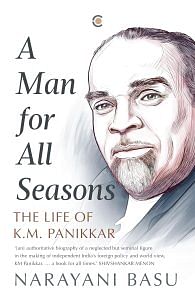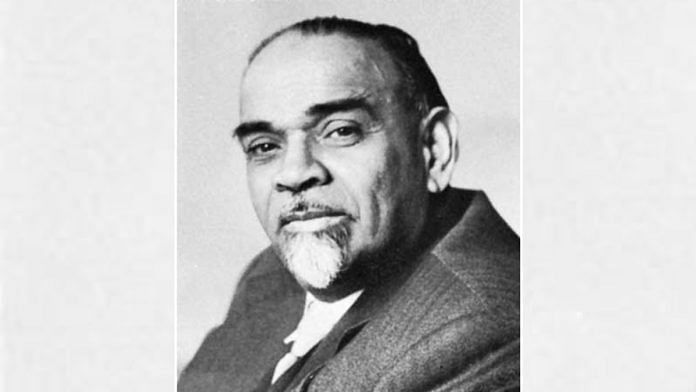Meanwhile in Bikaner, Panikkar was happily far from the national movement. He and Ganga Singh had got off to a somewhat unusual start. When Panikkar presented his credentials to the maharaja, he handed over a typed sheet of paper. When Ganga Singh inquired what it was, Panikkar answered cheekily, ‘It is my dismissal order. The day you do not feel the need for my services please sign it and return it to me.’ He produced another sheet of paper. ‘This is my resignation letter, which I have signed and the day I feel that I do not want to work for Your Highness, I will put the date on it and hand it to you.’
After that, unsurprisingly, there were no problems with the Maharaja of Bikaner.
When Panikkar’s grandson, Parvathy’s son Madhavan Nair, heard this story many years later, he was incredulous. But his grandfather was delighted to explain that the first thing he used to do whenever he entered office for the first time was to dictate his resignation letter and keep it in his waistcoat pocket.
‘Show me,’ Madhavan demanded.
Panikkar promptly fished it out of the waistcoat he was wearing that day.
Bikaner’s new foreign minister also did not like to abide by royal customs. Just as Panikkar had made his presence felt to Nehru in the days of his mission in Amritsar, so too did he make it clear to Ganga Singh that he would not kowtow to anyone, regardless of their position. In Bikaner, the custom was to refer to the ruler as annadaata (giver of food). Panikkar flatly refused to do so, intriguing Ganga Singh into asking him why.
‘Who is whose annadaata?’ Panikkar retorted, delighting the maharaja into quick laughter.
Apart from getting the better of Ganga Singh, Panikkar was also finally not thinking incessantly about constitutional reform or princely intrigues. His days once again found a nice, quiet routine. Every morning, he spent an hour with his works of Malayalam. His novel on Pazhassi Raja, the classic that was to become Kerala Simham, was almost complete. He was also working on a spate of other Malayalam poems, which would all be published between 1940 and 1942. In between these endeavours, he also kept an eye on his children.
The eldest daughters—Parvathy and Devaki—were young women, ready to go to university. In those days, the leading colleges were Delhi College (the oldest), located outside the walled city’s Ajmeri Gate, St Stephen’s College and Hindu College, both at Kashmere Gate at the time. Indraprastha College, then the only college for women, was located on the Delhi ridge some distance away. That was all there was of the University of Delhi in those days, and it was the single-handed creation of the bushy-browed Sir Maurice Gwyer.
Also read: The first googly was a party trick. A British cricketer discovered it with a tennis ball
Born in London in 1878, Gwyer came to India in 1937 as the first chief justice of the Federal Court of India, but with war on the horizon, Linlithgow gave him the additional portfolio of vice chancellor of Delhi University (DU) in 1938. A fellow of All Souls in Oxford, Gwyer wanted this campus to be akin to his beloved Oxbridge, an all-India university beyond compare. In 1939, he submitted a memorandum asking for a number of professorial chairs, fellowships, scholarships and readerships to be set up. Today’s threeyear BA and BSc pass and honours degree courses were introduced during Gwyer’s time. He invited the richest minds of the time to lecture at DU, from V.K.R.V. Rao to E.M. Forster and Homi Bhabha.
Gwyer was both brilliant and sociable, and on his long list of friends, he counted K.M. Panikkar. With two daughters of college age and a son not far behind, Panikkar suggested chattily that DU must have its own campus, with constituent colleges located at proximity across that campus. Gwyer liked the idea, and with Panikkar’s encouragement, the old Viceregal Lodge became the Vice Chancellor’s Office of today, and Hindu College and St Stephen’s College shifted location to the new campus.
Parvathy was sent to Indraprastha College, which had a hostel on campus. The plan was for Devaki, always the rebel, to follow suit. But she obediently kept her head down, studying for her intermediate degree in Indraprastha College along with her sister. Both were excellent with languages, fluent in Bengali that they’d picked up in Calcutta and Sanskrit that they’d learnt observing from their father. Now that they were growing up, it is easier to see how patterns of sibling closeness developed, born from the circumstances of their schooling. Parvathy and Devaki were and always would be very close, since they had grown up together, far away from home. In a similar vein, Haima and Radha were very close. They too grew up together, away from home. Madhusudan, the keenly intelligent, quiet, bespectacled little boy, grew into his teens alone in Delhi, far from the comforts of home and his siblings. His circumstances led to a curious kind of introverted brilliance. Madhusudan would eventually follow in his father’s academic footsteps, but he would always feel overlooked and isolated in comparison to the rest of his family. ‘I think he always felt like his father didn’t do enough for him,’ says a grandniece.
When Parvathy and Devaki arrived in Delhi to continue their education, life for all the siblings brightened a bit. Now, they had a chance to be together during school or university breaks, with the two youngest catching the Kalka Mail to New Delhi. Madhusudan would pick them up at the railway station, and together they would go towards what is North Campus today to spend time with Parvathy and Devaki.
While the children grew accustomed to these changing patterns of life, Gouri was trying to get used to yet another new princely state. To keep her mind busy, she did what came naturally to her: focusing on learning new skills, new languages, new ways of cooking and carpentry. She had plenty of time on her hands now, for all the children were away at university or finishing school.
It was at this time that a young man by the name of Kuttappa Panicker (though no relation of theirs) seems to have come to stay in the Panikkar home. It was hard to find fellow Malayalis so far north, and Kuttappa was affectionately treated as a member of the family. He was a part-time astrologer of some repute, drawing Panikkar’s reluctant interest. The older man was not, by nature, superstitious, nor did he believe too much in the ways of the stars and planets. But since his own and Gouri’s horoscopes had been cast at their respective times of birth, he continued the tradition for his children and for some of the grandchildren that were yet to come. For those purposes, he relied only on Kuttappa.
The doors of the Panikkar home were also flung open to many guests, most of whom were travelling through India or Asia or transiting through Bikaner. Panikkar was now seen as highly influential: a powerful man with a clever, resourceful mind and a persuasive pen. The ICS officer Maurice Zinkin and his fascinating wife, the journalist Taya Zinkin, often stayed with Gouri and Panikkar, and in the course of time, the two couples became excellent friends. When she arrived in India, Taya came to see Panikkar, intrigued by a common friend’s description: ‘When you go to India do not miss meeting Mephistopheles; he is the most entertaining and enthralling character in the subcontinent!’
 This excerpt from Narayani Basu’s ‘A Man for All Seasons: The Life of K.M. Panikkar’ has been published with permission from Westland Books.
This excerpt from Narayani Basu’s ‘A Man for All Seasons: The Life of K.M. Panikkar’ has been published with permission from Westland Books.






